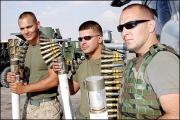

| HOME | HISTORY | ARTICLES | RESOURCES | DIRECTORY | SITE MAP |
|
Looking for Peace in Iraq
Despite increased U.S. military operations and the stepped-up training of Iraqis, the Iraq insurgency continues to be deadly—nearly 3 U.S. soldiers died per day in August. Dwarfing that number are Iraqi deaths as a result of the fighting which average 34 every day. What’s most troubling about the attacks is their nature: they largely target innocent civilians. Recently the Iraq Ministry of Interior estimated that insurgent violence has claimed the lives of 12,000 Iraqi civilians since the war began. Nearly all Iraqis universally condemn these killings. There are even incidents now where some elements of the insurgency are attacking insurgents who target Iraqis. The United States has been unable to quell the insurgency—in fact, the military can’t even secure a six-mile highway from the Baghdad airport to the city. Killing and jailing insurgents hasn’t worked. Former Department of Defense General Jack Keane estimated two months ago that more than 50,000 insurgents have been killed so far, but their active ranks remain between 16,000 and 20,000. The United States has shown all insurgents in the Muslim world that military power and occupation can’t conquer their hearts and minds. Recent declarations by U.S. and Iraqi officials that significant troop reductions may begin in early 2006 are welcome because they finally reflect reality—the insurgency in its different forms can’t be defeated on the military battleground. The reason is simple. In every successful insurgency movement, you have to have a core group surrounded by multiple circles of support—much as an onion has layers upon layers over its center. At the core of the insurgency are the fighters. They are surrounded by layers of support that enable their function: people who provide or store weapons; others who provide financing and other needed supplies; and even those who allow the insurgents to hide. Outer layers of this support are still powerful. Some people provide information to the insurgency and many others provide the psychological support to the insurgents. And there are others who provide support through their acquiescence, silence, and indifference. All of these elements create the breeding grounds for a continued insurgency. And the primary cause for these layers of support is opposition to the U.S. occupation. Unfortunately, most policymakers, pundits, and politicians (Republicans or Democrats) don’t talk about the elephant in the room: the occupation. They would rather discuss victory strategies than face the reality that Iraqis are fighting the “liberators” and occupiers. Recently, I acted as a translator for a day to labor leaders from Iraq who were touring the United States. These courageous Iraqis spanned my native country’s entire political spectrum. But they all were against the insurgents and at the same time wanted to end the occupation as soon a possible and peacefully. Moreover, over 100 members of the Iraqi parliament have signed a petition calling to end the occupation. There are three things that could restore peace in Iraq: First, the United States (and UN Security Council) must establish guarantees that the U.S. occupation will end. It should be made clear that it is the policy of the United States to leave Iraq as soon as possible. Second, the United States should declare that it has no intention of maintaining any permanent U.S. bases on Iraqi soil and cease building new military facilities. Finally, the Iraqi government, UN agencies, and the United States should establish a set of benchmarks that can be used as a roadmap for getting out of Iraq and quickly. The United States has been forceful in pushing forth timelines for Iraqis to meet—it is now time for the United States to do the same by setting their own benchmarks and timelines. Iraqis, the U.S. public, and now even members of the U.S. Congress are calling for an exit strategy. It’s time for President Bush to hear these calls of the people and explain what the plan is and when U.S. troops will come home. |
Copyright 2025 Boycottus.net All rights reserved.
|
 Military power and occupation can’t conquer hearts and minds
Military power and occupation can’t conquer hearts and minds